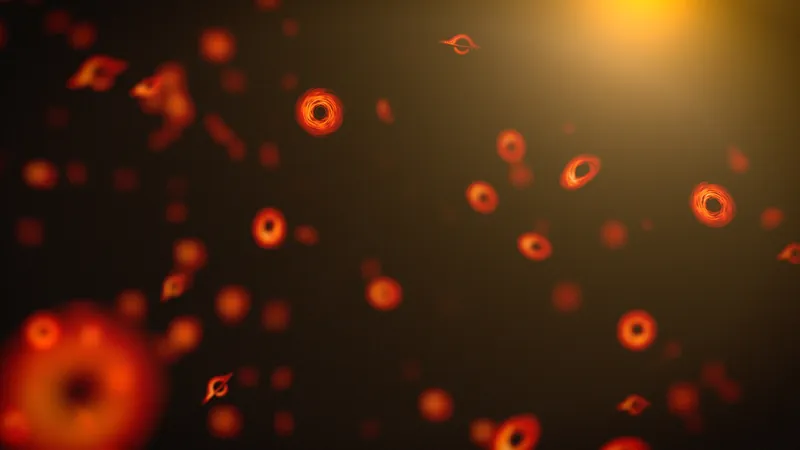
Are We on the Verge of Discovering Primordial Black Hole Mergers? The Dark Matter Mystery Deepens!
2024-11-16
Author: Wei Ling
The Elusive Primordial Black Holes
Imagine a black hole with the mass of the dwarf planet Ceres—so minuscule it would be smaller than a bacterium and practically invisible. If such primordial black holes, born from the intense conditions of the early Universe shortly after the Big Bang, are indeed prevalent, they could have profound influences on the movements of stars and galaxies—potentially explaining the elusive nature of dark matter.
Formation and Implications
Primordial black holes could not arise from the remnants of dying stars; rather, they are thought to have formed in the hot, dense soup of particles that characterized the early cosmos. While there is currently no direct evidence for their existence, astronomers are motivated by the possibility that these tiny black holes could offer a viable explanation for the dark matter that seems to dominate the Universe's mass yet remains unseen.
Current Observations and Limitations
Current data has largely ruled out the existence of large primordial black holes, as their interactions would visibly alter galaxy clustering in ways we do not observe. On the other hand, black holes with masses comparable to that of a mountain have likely evaporated by now due to Hawking radiation. However, the existence of asteroid-mass black holes remains plausible; they haven't been discounted, which has spurred fresh investigations.
New Study on Gravitational Waves
A compelling new study proposes that we may detect these asteroid-mass primordial black holes through their gravitational waves, created during mergers. For primordial black holes to account for dark matter, they would need to be extraordinarily common, especially if they occupy the mass range akin to asteroids. In galactic environments, their frequent mergers would generate gravitational 'chirps' similar to those produced by more massive stellar black holes, albeit at much higher frequencies.
Challenges in Detection
Currently, gravitational wave observatories like LIGO are not equipped to detect these higher-frequency signals, but researchers suggest that dark matter experiments might hold the key. One intriguing possibility involves an exotic particle called the axion—initially theorized to address challenges in particle physics, axions have garnered interest in cosmology as potential dark matter candidates. Previous attempts to detect axions have yielded no conclusive results, but the authors of the study propose modifications to existing axion observation methods to see if the chirps from black hole mergers could be detected under ideal conditions.
The Road Ahead
The road to discovery could be arduous. It's improbable that primordial black holes exist solely within the specific mass range required for them to be dark matter candidates, and the chances of favorable observations are slim. Nevertheless, embarking on this investigative quest could offer astronomers invaluable insights into the enigmatic nature of dark matter—a mystery that continues to elude our understanding.
Conclusion
As scientists strive to decode the Universe's secrets, the prospect of detecting primordial black hole mergers might not just be a long shot—it's a potentially revolutionary breakthrough that could redefine our understanding of dark matter and the cosmos itself! Stay tuned as this story unfolds!






 Brasil (PT)
Brasil (PT)
 Canada (EN)
Canada (EN)
 Chile (ES)
Chile (ES)
 España (ES)
España (ES)
 France (FR)
France (FR)
 Hong Kong (EN)
Hong Kong (EN)
 Italia (IT)
Italia (IT)
 日本 (JA)
日本 (JA)
 Magyarország (HU)
Magyarország (HU)
 Norge (NO)
Norge (NO)
 Polska (PL)
Polska (PL)
 Schweiz (DE)
Schweiz (DE)
 Singapore (EN)
Singapore (EN)
 Sverige (SV)
Sverige (SV)
 Suomi (FI)
Suomi (FI)
 Türkiye (TR)
Türkiye (TR)